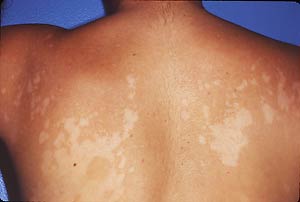A 13-year-old biracial girl with asymptomatic rash
A 13-year-old biracial girl presented to the clinic in July with an asymptomatic rash on her back that she reported had been there for several weeks.
She reported a past history of “ringworm” on her chest but recalled that rash being pruritic. Her mother was concerned that the lesions were becoming more extensive, now involving her shoulders, and would like treatment.
There are no pets in the child’s home. No other family members have similar skin findings. Her mother had tried no topical preparations. The patient did report spending time in the sun and using sunscreen. She was otherwise well. She denied any systemic complaints. Family and social history are non-contributory.
On exam, she is a pleasant, tanned girl in no acute distress. Involving her chest, shoulders and upper back are multiple minimally scaly hypopigmented macules coalescing into patches without evidence of erythema (Figure 1). Her scalp, face and the remainder of her skin are clear.

Did you identify the rash? Click to the next page to find out.
Answer
The answer is tinea versicolor. Tinea versicolor is an asymptomatic superficial fungal infection typically affecting the upper trunk and occasionally the neck and face.
This condition is caused by the fungus known as Malassezia furfur, more specifically the dimorphic lipophilic yeast forms Pityrosporum ovale and Pityrosporum orbiculare. This ubiquitous yeast is considered to be part of the normal skin flora, inhabiting the scalp. Tinea versicolor is commonly seen in adolescents during the summer months. Unaffected skin tans normally, but the lesions remain relatively hypopigmented because the organism produces an inhibitor of tyrosinase, which prevents tanning. It is most common in tropical climates but is also found in temperate climates.
Tinea versicolor is typically described as asymptomatic hypo- or hyperpigmented round to oval scaly macules, patches or thin plaques on the upper back, arms and less often on the face and neck. Because lesions can be either light or dark in color, the index of suspicion should be high when they appear in the characteristic pattern and distribution. Pruritus may occur when the lesions are inflammatory. In fair-skinned patients, the lesions may be insignificant during the winter months. The differential diagnosis includes pityriasis alba, postinflammatory hyper- or hypopigmentation, seborrheic dermatitis, progressive macular hypomelanosis of the trunk, vitiligo, pityriasis rosea, secondary syphilis, tinea corporis, confluent and reticulate papillomatosis of Gougerot and Carteaud, and psoriasis.
The disease can be found on patients of any age but is thought to be most common in adolescents and young adults likely due to its liphophilic nature and therefore predilection for people with increased sebaceous activity. It is sometimes seen in younger children, more commonly on the face. The disease less often affects older patients.
Diagnosis is usually made by clinical evaluation. Lesions can be gently scraped with a #15 blade to produce a fine white scale. With a potassium hydroxide wet-mount, one sees numerous short, wide hyphae surrounded by groups of budding spores which is known as the classic “spaghetti and meatballs” appearance under the microscope. Culture is typically not necessary. Wood’s lamp is another option for diagnosis in which the lesions appear bright yellow or gold under fluorescent light. However, this may be of low yield.

Treatment options
Treatment is generally topical with the understanding that recurrence rates are as high as 60%, and pigmentary changes may take many months to resolve. There are several successful treatment strategies for treatment. Selenium sulfide 2.5% lotion is a cheap, simple solution. Patients should apply a thin layer from the back of the scalp to the thighs and leave on for 10 minutes prior to rinsing daily for one to two weeks then monthly thereafter. They should also use this lotion as a shampoo for two weeks. Ketoconazole 2% shampoo can be used in a similar manner but left on for only five minutes either as a single treatment or daily for three days. Terbinafine solution as a 1% spray can be applied once to twice daily for one week. Other antifungal creams can be applied topically, but this is less economical due the large areas of involvement.
Short courses of oral antifungals such as ketoconazole, itraconazole or terbinafine work well for more resistant or extensive disease and, when taken, should be followed by vigorous exercise because they are excreted in sweat and thus reach the skin more effectively. Griseofulvin is ineffective for tinea versicolor.
For more information:
- Marissa J. Perman, MD, is a PL-III resident at Cincinnati Children’s Hospital Medical Center.
- Gupta AK, Batra R, Bluhm R, et al. Pityriasis versicolor. Dermatol Clin. 2003;21:413-29.
- Habif, TP. Clinical Dermatology: A Color Guide to Diagnosis and Therapy. Philadelphia: Mosby, 2004;451-54.
- Paller, AS, Mancini, AJ. Hurwitz Clinical Pediatric Dermatology. A Textbook of Skin Disorders of Childhood and Adolescence. Philadelphia: Elsevier, 2006;461-63.
- Perman M, Sheth P, Lucky AW. Progressive Macular Hypomelanosis: Case report and review of the literature. Pediatric Dermatology, 2007, in press.
Spot the Rash is a monthly case study featured in Infectious Diseases in Children designed to test your skills in pediatric dermatology issues.
